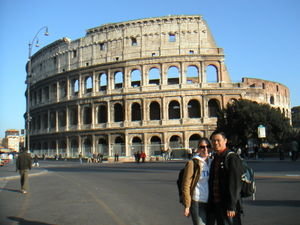Advertisement
Published: April 10th 2008

 The Colosseum
The Colosseum
This is the largest monument of imperial Rome in existence. It is an amphitheatre where gladiators fought to the death with wild beasts. Construction started in AD72.Buongiorno! It’s our last night in Rome so we thought we’d put up our pictures before going to bed. Tomorrow morning we pick up our rental car and start driving north. Our plan, as long as we don’t get too lost, is to make our way to the beautiful medieval city of Siena and then finally we will arrive in Florence tomorrow evening where we will stay for three nights. After Florence we will be spending one night in Pisa, one night in Verona, and then three nights in Venice. We will put up another blog post later with more pictures from our Italian adventure. For now here’s an update on our time in Rome.
We arrived at Rome Ciampino airport last Saturday morning and made our way to our hotel. We spent the afternoon and evening exploring central Rome and taking in the excitement of the Italian streets. Sunday was when we first started to visit the ‘big’ sites. We spent the morning at a giant flea market in the southwest of Rome. It was fun trying to haggle with the merchants and street vendors and we picked up a couple Italia sweaters as souvenirs. We walked along the local
river which led us to the Colosseum. In our opinion the Colosseum was the most exciting site. It is the largest monument of imperial Rome in existence. It is an amphitheatre where gladiators fought to the death with wild beasts. As you will see in the pictures much of the structure has eroded but conservation is ongoing. After the Colosseum, we visited Foro Romano (Roman Forum). The Forum is in ruins and was the political, commercial, economic and religious focal point of Republican Rome. The Forum was the hub of daily life in the days of ancient Rome. It began life as a market. We stopped for dinner at one of the local pizzerias (there are a lot of local pizzerias!) and then went to see the Trevi Fountain at night.
We spent the better part of Monday in Vatican City. We went through the many museums where many works by Bernini, Michelangelo, and Raphael are displayed. The Vatican is also home of the Sistine Chapel and Michelangelo’s famous frescoes. The Chapel was built by Pope Sixtus IV between 1473 and 1481, both as the pontiff’s private chapel and as a venue for the conclave of cardinals that gathers
to elect each new pope. The chapel attracts up to 20,000 visitors a day. Julius II commissioned Michelangelo to paint the ceiling of the Sistine Chapel in 1508 and Michelangelo completed it in 1512. Michelangelo was again commissioned in 1535 by Paul III to decorate the altar wall with scenes of the Last Judgement. The altar wall was completed in 1541. Photographs were not allowed in the Chapel. Afterwards we went into St. Peter’s Basilica. This is the most famous church in Christendom. It is the spiritual capital of the Roman Catholic faith and the focus of the Vatican City. We climbed over 500 stairs to reach the top of the dome which gave us a fantastic aerial view of Rome. We spent the rest of the day at the Spanish Steps and Trevi Fountain. The Spanish Steps were constructed in the 1720s. It is famous as a meeting place for visitors from all over the world. Trevi Fountain was built in 1762. This fountain is the most photographed fountain in Rome. In the middle, Neptune rides a shell-shaped chariot drawn by seahorses steered by giant tritons. Myth: toss two coins over your shoulder into the fountain, make a wish
and, it is said, you will return to Rome and your wish will come true.
On Tuesday we went to a couple of grand churches: San Paolo and San Giovanni in Laterano. We also spent some time at the Pantheon. We sat in a café enjoying a coffee and hot chocolate while the sea of tourists buzzed around the Pantheon. The Pantheon is a pagan temple turned Christian church. The Pantheon was erected in 27BC in honour of the heavenly gods. It was then destroyed in the great fire of AD80 and was rebuilt in the early second century. It is also home to the grave of the artist Raphael.
On Wednesday we ventured about 25 km outside of Rome to Ostia Antica. It is Italy’s best-preserved Roman settlement after Pompei. All that remains of this once bustling town is ruins.
There are a few things we’ve noticed during our time in Rome. There are lots of piazzas (pedestrian squares), pizzerias, gelato stands, and beggars. Citizens LOVE their espresso. One thing that takes away from the beauty of the city is the amount of garbage on the streets. Drivers are always honking their horns and are very
aggressive. Public transport is cheap but not very convenient as there are only two metro lines. Lastly, there are no toilet seats in most public toilets and use of the toilets often cost money. However, nearly everyone we encountered spoke English and all of the food we ate was delicious. Mmm...we love Italian cuisine!
Overall, we enjoyed the historic sites of Rome and look forward to the rest of our Italian adventure!
Advertisement
Tot: 0.154s; Tpl: 0.035s; cc: 7; qc: 46; dbt: 0.0515s; 1; m:domysql w:travelblog (10.17.0.13); sld: 1;
; mem: 1.2mb

























Mom
non-member comment
Oh wow - what a terrific trip you're having. Thanks for sharing it with everyone. I miss you guys but love your adventures!